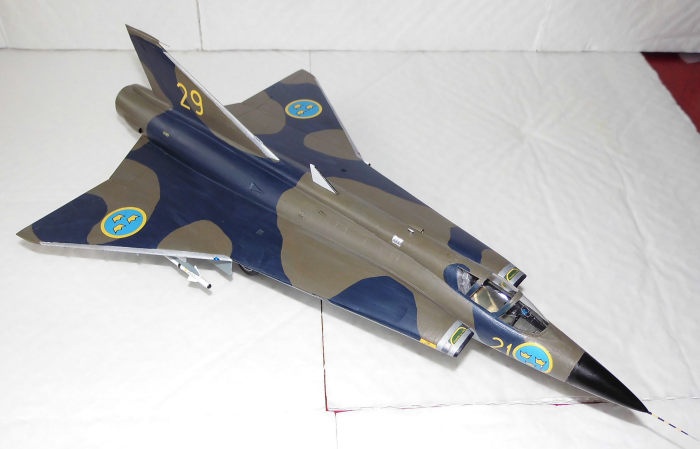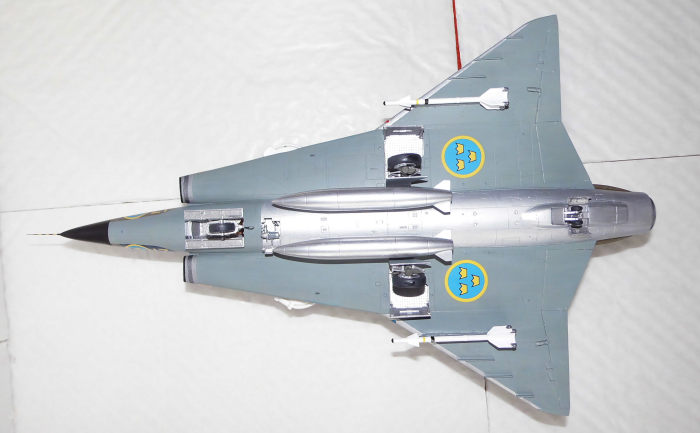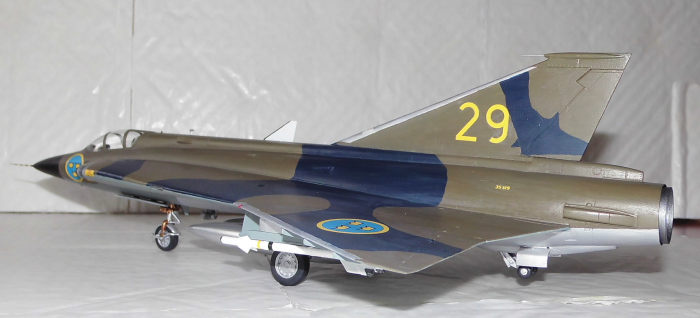
Hasegawa 1/48 Saab J.35D Draken
| KIT #: | 09888 |
| PRICE: | $ |
| DECALS: | Two options |
| REVIEWER: | Nicolai Plesberg |
| NOTES: | Parts and decals from other builds plus a few scratch-build items to produce a D. |

| HISTORY |
The first two operational variants
of the Saab Draken, the J35A and the J35B, were in fact rather limited in both
operational capability as well as performance so Saab developed further on the
Draken design. The result was, of some called the “second generation” Draken,
the J35D. It had first and foremost a more powerful engine, the Volvo Flygmotor
RM6C – a Swedish licence built Rolls-Royce Avon 300 Mk 60 with a new Swedish developed afterburner unit, the EBK 67, giving substantially more
thrust over the RM6B (Avon 300 Mk 48) with the EBK 66 afterburner fitted to the
J35B and late production J35As. The more powerful engine required more slender
and longer air intakes to fulfil the increased air demand specs for the new
engine.
a new Swedish developed afterburner unit, the EBK 67, giving substantially more
thrust over the RM6B (Avon 300 Mk 48) with the EBK 66 afterburner fitted to the
J35B and late production J35As. The more powerful engine required more slender
and longer air intakes to fulfil the increased air demand specs for the new
engine.
Other modifications includes the fin tip which was slightly redesigned, the external fuel tankage was doubled as new twin T52 pylons replaced the single pylon on the earlier variants allowing for an extra 500 litre drop tank to be carried plus the internal fuel capacity was increased as well and radar and other electronics were upgraded. The prototype for the J35D flew on 27 December 1960 and serial production began in 1962. By 1963 120 Ds had been delivered to Flygvapnet, but a part of the first production batch was later rebuilt into recce configured S35Es. Because of its clean configured airframe and the more powerful engine / afterburner combination the J35D also happened to be the fastest of all Draken variants literally being able to accelerate until out of fuel; this means that an exact maximum speed is not possible to determine other than it can be described as “Mach 2 +”. The J35D remained in service until 1984, but 24 was bought back by Saab in 1985, refurbished, and exported to Austria in 1987-89 as J35Ös.
| THE KIT |
The basic kit for this project is a boxing for an Austrian J35Ö, but Austrian Drakens were in fact, as explained earlier, refurbished J35Ds so the difference between them is not much. I got a D canopy and other parts, most notably sprue C containing the correct fin tip as well as tail cone for the D (the D not having chaff / flare dispensers mounted on the afterburner cooling scoops) from other boxings and the decals surplus from other builds as well. The rest of the parts are by now well known…. so on to construction.
| CONSTRUCTION |
 In a break
with the way I normally model a 1/48 Hasegawa Draken, I began construction by
picking out any subassemblies available to ease things along. So outer wing
sections (except the tips), the fin (with the intake at the base hollowed out
alright), the nose (including the weight), burner can except the outermost part
(L19), drop tanks and their pylons, which were glued together. I also modified
the outer wing pylons so they would resemble the ones used for carrying a
launcher rail for Rb24 missiles (AIM-9B Sidewinders). The reason for choosing
this approach, was, that I began this project at a meeting between fellow
modelers on a Saturday afternoon. This of course limited what tools I could
bring with me, but nevertheless I achieved my set goals for this project. Back
at home I could continue from my initial efforts; i.e. attaching the wing tips
to the outer wing sections, drilling the holes for the pitot probes and gluing
the fin top to the fin as well as dealing with the seams on those assemblies.
The remaining of the build followed more or less the same proceedings I have
outlined before. As soon as the airframe was complete with the gear mounted and
in cleaned condition, the model went to the paint shop.
In a break
with the way I normally model a 1/48 Hasegawa Draken, I began construction by
picking out any subassemblies available to ease things along. So outer wing
sections (except the tips), the fin (with the intake at the base hollowed out
alright), the nose (including the weight), burner can except the outermost part
(L19), drop tanks and their pylons, which were glued together. I also modified
the outer wing pylons so they would resemble the ones used for carrying a
launcher rail for Rb24 missiles (AIM-9B Sidewinders). The reason for choosing
this approach, was, that I began this project at a meeting between fellow
modelers on a Saturday afternoon. This of course limited what tools I could
bring with me, but nevertheless I achieved my set goals for this project. Back
at home I could continue from my initial efforts; i.e. attaching the wing tips
to the outer wing sections, drilling the holes for the pitot probes and gluing
the fin top to the fin as well as dealing with the seams on those assemblies.
The remaining of the build followed more or less the same proceedings I have
outlined before. As soon as the airframe was complete with the gear mounted and
in cleaned condition, the model went to the paint shop.
| COLORS & MARKINGS |
 Well, the
colors are the same as my
S35E
so no news in that, but the camouflage scheme is a bit different. The only part
that is pretty accurate is on the left hand side and, partially, the left upper
wing because of the photo I used for reference (see reference section for more
info on that). The rest, I’m afraid, I had to “artistic” it a bit, but it went
surprisingly easy. The decals were scrounged from other Draken builds and I was
actually quite lucky that the main markings (national insignia, numbers and most
stencils) were available, but my decal dungeon delivered a few generic stencils
to fill in the blanks. Upon completing decaling they were sealed with gloss
before applying the final flat coat.
Well, the
colors are the same as my
S35E
so no news in that, but the camouflage scheme is a bit different. The only part
that is pretty accurate is on the left hand side and, partially, the left upper
wing because of the photo I used for reference (see reference section for more
info on that). The rest, I’m afraid, I had to “artistic” it a bit, but it went
surprisingly easy. The decals were scrounged from other Draken builds and I was
actually quite lucky that the main markings (national insignia, numbers and most
stencils) were available, but my decal dungeon delivered a few generic stencils
to fill in the blanks. Upon completing decaling they were sealed with gloss
before applying the final flat coat.
The final bits consisted of painting and gluing the final bits in place including two AIM-9B Sidewinder missiles from Hasegawa’s weapon set C disguised as Rb24 Sidewinders. A little 101 on the Rb24: the original Rb24 missile is based on the first operational version of the Sidewinder, the AIM-9B. The upgraded Rb24J is based on the AIM-9J, while the AIM-9L was designated Rb74 in Swedish service. The latter is only for JA37s and JAS 39s. Some say that RB74s were also found in the arsenal of J35Js, but I guess it’s a matter of bad recognition between the forward fins of the Rb24Js and Rb74s because I’ve only seen the cranked fins of Rb24Js on J35J Drakens!
| CONCLUSIONS |
 This is
probably an easy conversion as all the parts needed has been tooled by Hasegawa,
but until recently were in separate boxings. I believe that Hasegawa in the
meantime has been proactive and released a dedicated D boxing which is of course
nice. I, on the other hand, am happy to have modeled a D without having to buy
the D boxing because I had the knowledge and parts to do it. If you want to
model earlier versions then Maestro Models can deliver parts for those
conversions, i.e. early air intakes, fin tip etc. and including a conversion set
to make the two-seat Sk35C. As I’ve stated before that Hasegawa’s 1/48 Draken is
for modelers with moderate experience.
This is
probably an easy conversion as all the parts needed has been tooled by Hasegawa,
but until recently were in separate boxings. I believe that Hasegawa in the
meantime has been proactive and released a dedicated D boxing which is of course
nice. I, on the other hand, am happy to have modeled a D without having to buy
the D boxing because I had the knowledge and parts to do it. If you want to
model earlier versions then Maestro Models can deliver parts for those
conversions, i.e. early air intakes, fin tip etc. and including a conversion set
to make the two-seat Sk35C. As I’ve stated before that Hasegawa’s 1/48 Draken is
for modelers with moderate experience.
| REFERENCES |
Saab 35 Draken Walk Around © 2010 Squadron Signal Publications ISBN 978-0-89747-612-6
Nordic Airpower vol. 2: Flygvapnet Scenes from Swedish military aviation history By Anders Nylén and Jan Jørgensen ISBN 978-87-993688-1-5. The picture at the bottom of page 52 directly inspired me to this build as it shows J35D, 35329, from F21 at Luleå in 1973.
www.robotmuseum.se For information on all missiles used by Flygvapnet this website tells the story on each air to air / air to ground missile (missile = robot in Swedish).
11 January 2022
Copyright ModelingMadness.com. All rights reserved. No reproduction in part or in whole without express permission.
If you would like your product reviewed fairly and fairly quickly, please contact the editor or see other details in the Note to Contributors.